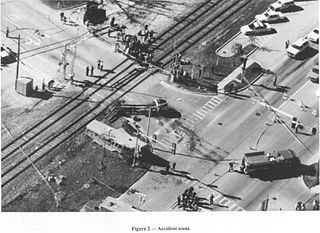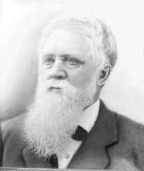
The City of New Orleans is a long-distance passenger train operated by Amtrak in the Central United States between Chicago and New Orleans. The overnight train takes about 191⁄2 hours to complete its 934-mile (1,503 km) route, making major stops in Champaign–Urbana, Carbondale, Memphis, and Jackson as well as in other small towns.
The Pere Marquette Railway was a railroad that operated in the Great Lakes region of the United States and southern parts of Ontario in Canada. It had trackage in the states of Michigan, Ohio, Indiana, and the Canadian province of Ontario. Its primary connections included Buffalo; Toledo; and Chicago. The company was named after Jacques Marquette, a French Jesuit missionary who founded Michigan's first European settlement, Sault Ste Marie.
The Lake Shore and Michigan Southern Railway, established in 1833, and sometimes referred to as the Lake Shore, was a major part of the New York Central Railroad's Water Level Route from Buffalo, New York, to Chicago, Illinois, primarily along the south shore of Lake Erie and across northern Indiana. The line's trackage remains a major rail transportation corridor used by Amtrak passenger trains and several freight lines; in 1998, its ownership was split at Cleveland, Ohio, between CSX Transportation to the east and Norfolk Southern Railway in the west.

On March 15, 1999, Amtrak's southbound City of New Orleans passenger train collided with a semi-trailer truck in the village of Bourbonnais, Illinois, United States. Most of the train derailed, killing eleven people. A National Transportation Safety Board (NTSB) investigation into the accident attributed the cause to the truck driver trying to beat the train across a grade crossing. The NTSB's recommendations from the accident included increased enforcement of grade crossing signals, the installation of train event recorders at all new or improved grade crossings, and procedures to provide emergency responders with accurate lists of all crew members and passengers aboard trains. The city of Bourbonnais erected a memorial near the site to commemorate those killed in the accident.

Greater Grand Crossing is one of the 77 community areas of Chicago, Illinois. It is located on the city's South Side.

The Hammond circus train wreck occurred on June 22, 1918, and was one of the worst train wrecks in U.S. history. Eighty-six people were reported to have died and another 127 were injured when a locomotive engineer fell asleep and ran his troop train into the rear of a circus train near Hammond, Indiana. The circus train held 400 performers and roustabouts of the Hagenbeck–Wallace Circus.

The Michigan Central Railroad was originally chartered in 1832 to establish rail service between Detroit, Michigan, and St. Joseph, Michigan. The railroad later operated in the states of Michigan, Indiana, and Illinois in the United States and the province of Ontario in Canada. After about 1867 the railroad was controlled by the New York Central Railroad, which later became part of Penn Central and then Conrail. After the 1998 Conrail breakup, Norfolk Southern Railway now owns much of the former Michigan Central trackage.

The 1995 Fox River Grove bus–train collision was a grade crossing collision that killed seven students riding aboard a school bus in Fox River Grove, Illinois, on the morning of October 25, 1995. The school bus, driven by a substitute driver, was stopped at a traffic light with the rearmost portion extending onto a portion of the railroad tracks when it was struck by a Metra Union Pacific Northwest Line train, train 624 en route to Chicago.

The Pere Marquette is a passenger train operated by Amtrak as part of its Michigan Services on the 176-mile (283 km) route between Grand Rapids, Michigan, and Chicago, Illinois. It is funded in part by the Michigan Department of Transportation and is train 370 eastbound and train 371 westbound. The westbound train leaves Grand Rapids during the morning rush, and the eastbound train leaves Chicago after the afternoon rush, enabling same-day business travel between the two cities.

A collision between two commuter trains in Chicago occurred during the cloudy morning rush hour on October 30, 1972, and was the worst such crash in Chicago's history. Illinois Central Gulf Train 416, made up of newly purchased Highliners, overshot the 27th Street station on what is now the Metra Electric Line, and the engineer asked and received permission from the train's conductor to back the train to the platform. This move was then made without the flag protection required by the railroad's rules. The train's crew had not used a flagman before, and while it was a prescribed practice, it had fallen out of use. Instead, the conductor and the engineer worked in concert to back up the train, with the curve in the track partially blocking the view.

The Purdue Wreck was a railroad train collision in Indianapolis, Indiana, on Saturday, October 31, 1903, between two special trains that killed 17 people, including 14 players of the 1903 Purdue University football team. Team captain and future Indiana governor Harry G. Leslie was initially thought to have died in the accident, but was later revived.

The Naperville train disaster occurred April 25, 1946, on the Chicago, Burlington and Quincy Railroad at Loomis Street in Naperville, Illinois, when the railroad's Exposition Flyer rammed into the Advance Flyer, which had made an unscheduled stop to check its running gear. The Exposition Flyer had been coming through on the same track at 80 miles per hour (130 km/h). There were 45 deaths and some 125 injuries. This crash is a major reason why most passenger trains in the United States have a speed limit of 79 mph (127 km/h).

The Norwalk rail accident occurred on May 6, 1853, in Norwalk, Connecticut, and was the first major U.S. railroad bridge disaster; 48 were killed when a train travelling at 50 miles per hour (80 km/h) plunged into the Norwalk Harbor off of an open swing bridge.

On the evening of February 3, 2015, a commuter train on Metro-North Railroad's Harlem Line struck a passenger car at a grade crossing on Commerce Street near Valhalla, New York, United States. Six people were killed and 15 others injured, seven severely. It is the deadliest crash in Metro-North's history, and was at the time the deadliest rail accident in the United States since the June 2009 Washington Metro train collision, which killed nine passengers and injured 80.

The Baker Bridge train wreck occurred on November 26, 1905, in Lincoln, Massachusetts, when two passenger trains on the Fitchburg line of the Boston and Maine Railroad were involved in a rear-end collision. Seventeen people were killed in the wreck. Engineer Horace W. Lyons was charged with manslaughter; however, a grand jury chose not to indict him.
The Swampscott train wreck occurred on February 28, 1956, in Swampscott, Massachusetts when a Danvers–Boston commuter train crashed into the rear of a stopped Portsmouth–Boston local train just north of the station during a snowstorm. The collision, blamed on the engineer operating at unsafe speeds for the conditions, killed 13 people and injured 283.
The Great Northern Buelow Wreck occurred on March 7, 1966, when two Great Northern Railway trains, an eastbound Empire Builder passenger train and a westbound Western Star mail and passenger train, collided near Chester, Montana. Two were killed, 77 were injured, and 29 were hospitalized.















